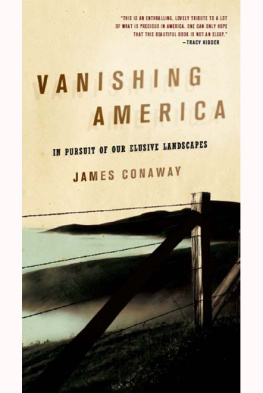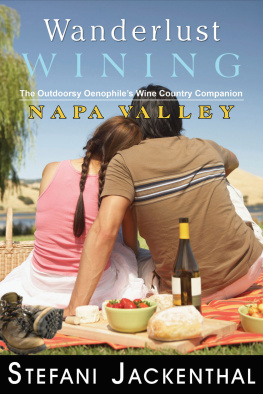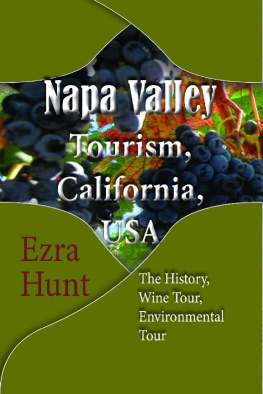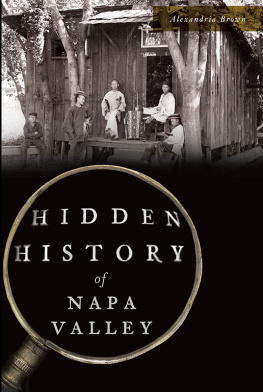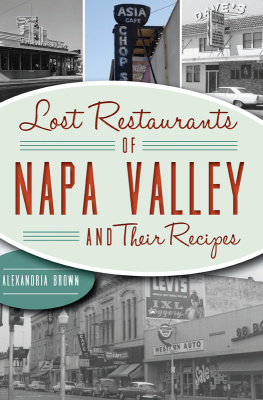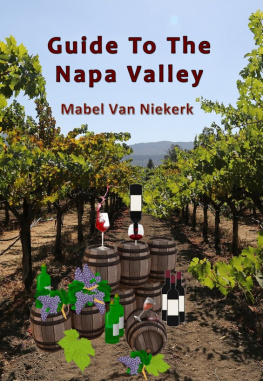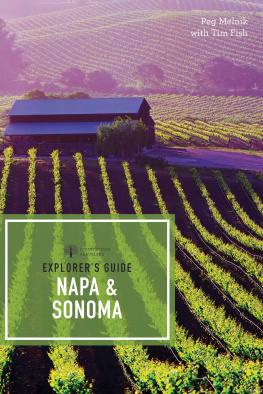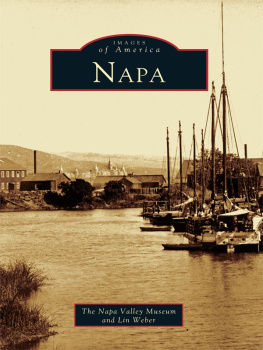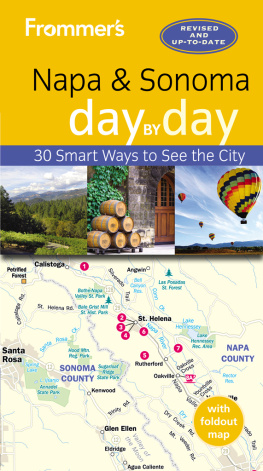First Mariner Books edition 2002
Copyright 1990 by James Conaway
ALL RIGHTS RESERVED
For information about permission to reproduce selections from this book, write to or to Permissions, Houghton Mifflin Harcourt Publishing Company, 3 Park Avenue, 19th Floor, New York, New York 10016.
hmhco.com
The Library of Congress has cataloged the print edition as follows:
Conaway, James, date
Napa / James Conaway
p cm
A Richard Todd book
Includes bibliographical references and index
ISBN 0-395-46880-9
ISBN 0-618-25798-5 (pbk)
ISBN 978-0-618-25798-0 (pbk)
1 Napa River Valley (Calif)History 2 Wine industryCaliforniaNapa River ValleyHistory I Title
F 868 N 2 C 66 1990 90-4708
979 4'19dc20 CIP
eISBN 978-0-547-52659-1
v3.0718
FOUNDERS
Charles Krug (Charles Krug Winery, 1860)
Jacob Schram (Schramsberg Vineyard, 1862)
Gustave Niebaum (Inglenook Vineyards, 1879)
Georges de Latour (Beaulieu Vineyard, 1899)
Louis Michael Martini (Louis M. Martini Winery, 1933)
Cesare Mondavi (Sunny St. Helena, 1937; Charles Krug Winery, 1943)
INHERITORS
John Daniel (Inglenook)
Hlne de Latour de Pms (Beaulieu)
Louis Peter Martini (Martini)
Robert Mondavi (Robert Mondavi Winery; Opus One)
Mary Mondavi (Krug)
Helen Mondavi (Krug)
Peter Mondavi (Krug)
THIRD GENERATION
Marcia Daniel Smith (Napanook/Dominus)
Robin Daniel Lail (Napanook/Dominus)
Dagmar de Pins Sullivan (Beaulieu)
Carolyn Martini (Martini)
Michael Martini (Martini)
Peter Martini (Martini)
Patricia Martini (Martini)
Michael Mondavi (Mondavi; Opus One)
Marcia Mondavi (Mondavi; Opus One)
Timothy Mondavi (Mondavi; Opus One)
Peter Mondavi, Jr. (Krug)
Marc Mondavi (Krug)
VINTNERS
Stan Anderson (S. Anderson Vineyard)
Gary Andrus (Pine Ridge Winery)
James Barrett (Chteau Montelena)
Sam Bronfman (Sterling Vineyards; Domaine Mumm) Tom Burgess (Burgess Cellars)
Jack Cakebread (Cakebread Cellars)
Chuck Carpy (Freemark Abbey)
Donn Chappellet (Chappellet Vineyard)
Francis Ford Coppola (Niebaum-Coppola Estate)
Jay Corley (Monticello Cellars)
Jack Davies (Schramsberg Vineyard)
Carl Doumani (Stags Leap Winery)
Dan Duckhorn (Duckhorn Vineyards)
Randy Dunn (Dunn Vineyards)
Tom Ferrell (Sterling)
Dennis Fife (Inglenook)
Ric Forman (Forman Winery)
Steve Girard (Girard Winery)
Miljenko (Mike) Grgich (Grgich Hills Cellar)
Dennis Groth (Groth Vineyard and Winery)
Bill Harlan (Sunny St. Helena Winery)
Joe Heitz (Heitz Cellars)
William Hill (William Hill Winery)
Agustin Huneeus (Franciscan Vineyards)
William Jaeger (Rutherford Hill Winery)
Reverdy Johnson (Johnson-Tumbull Vineyards)
Guy Kay (Beringer Vineyards)
Legh Knowles (Beaulieu)
Hanns Komell (Hanns Kornell Champagne Cellars)
Fred McCrea (Stony Hill Vineyard)
Dick Maher (Christian Brothers Winery)
Justin Meyer (Silver Oak Cellars)
Christian Moueix (Chteau Ptrus; Dominus)
Michael Moone (Beringer)
Peter Newton (Newton Vineyard)
Gil Nickel (Far Niente Winery)
Dick Peterson (Atlas Peak Vineyards)
Joseph Phelps (Joseph Phelps Vineyards)
Bernard Portet (Clos du Val Wine Company)
Mike Robbins (Spring Mountain Vineyards/Falcon Crest) Koemer Rombauer (Rombauer Vineyards)
Baron Philippe de Rothschild (Chteau Mouton-Rothschild; Opus One)
Tom Selfridge (Beaulieu)
John Shafer (Shafer Vineyards)
Jan Shrem (Clos Pegase)
Stuart Smith (Smith-Madrone Vineyards)
J. Leland Stewart (Souverain Cellars)
John Trefethen (Trefethen Vineyards)
Bob Trinchero (Sutter Home Winery)
Charles Wagner (Caymus Vineyard)
John Williams (Frogs Leap Wine Cellars)
Warren Winiarski (Stags Leap Wine Cellars)
John Wright (Domaine Chandon)
GROWERS
Andy Beckstoffer
Ren di Rosa
Volker Eisele
Andy Pelissa
Bob Phillips
1
F OR MORE THAN a year now they had been searching: on the highway, near the river, atop oaky knolls that rose abruptly from the valley floor, up wild canyons, and along the spines and scarps of two rugged coastal ranges. What they were looking for was not easily put into words, but the quality of the ideal was absolute and unassailable in their minds. They were searching for... They would know it when they found it.
They didnt want a hut in the woods. They didnt want a roadside attraction. They didnt want one of those Victorian piles built in homage to Europe, with too many rooms and too much view (views could be just as pretentious as architecture) and strange names like Chateau Montelena, Chateau Chevalier, Freemark Abbeywhite elephants all, and all for sale, with weeds in the yards and blank windows staring back into the illusions of the founders.
The couples name was Davies, and the fact that these near-ruins existed in an agricultural backwater given over to prune and walnut trees, pastures and some vines, intrigued them. The valley, named for the Napa River that flowed through it, was still tenuously connected to a process going back thousands of years and halfway round the world, to the Transcaucasus, south of the Caspian Sea, where similar vines clung to rocky ledges and the grapes were once placed in earthen pots, and the substance that came of them, wine, made its way down the Euphrates, through Egypt, Greece, imperial Rome, and France, to arrive at this redoubt in northern California sometime in the previous century.
Now, in the spring of 1964, Napa Valley was about to achieve something unique in Americaagain. Wine, lately considered the dubious beverage of immigrants, made in basements, would soon be transformed into a symbol of high culture, and winemakers would be heralded as artists. The owners of wineries themselves would be celebrated as a new class. These self-made baronetsformerly real estate speculators, developers, academics, brokers, dentists, oilmen, and purveyors of products as varied as frozen food and feature filmswould put their names on bottles, tacitly associating themselves with an older order and an endeavor above ordinary commerce. They would invite the public into a romantic association not unlike that involving movie idols and real royalty.
The children of these vintners would grow up on little fiefdoms, accustomed to the sight of workers among the vines and to the pleasures of life far from the raucous cities and suburbs their parents had left behind. They would reject the unsavory methods of earning the money required to have brought about such a change in their families fortunes. Some would seek to turn the land into tourist attractions, increasingly urged to exploit the place. Finally, the valley would take on a gloss that had more to do with money than with the product for which it became famous; it would be transformed into a paradigm of material ambition and dissent, threatened by the very brilliance of the imprint it left on the world.


